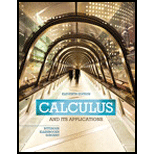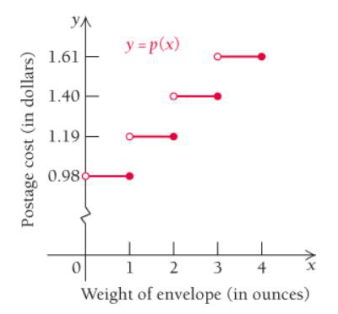
Concept explainers
The Postage function.
The cost of sending a large envelope via U.S. first-class mail in 2014 was $0.98 for the first ounce and $0.21 for each additional ounce (or fraction thereof). (Source; www.usps.com.) If x represents the weight of a large envelope, in ounces, then
And so on, up through 13 ounce. The graph of p is show below.

Using the graph of the postage function, find each of the following limit, if it exists.
Want to see the full answer?
Check out a sample textbook solution
Chapter 1 Solutions
Calculus and Its Applications (11th Edition)
Additional Math Textbook Solutions
Calculus: Early Transcendentals (3rd Edition)
Precalculus (10th Edition)
Single Variable Calculus: Early Transcendentals (2nd Edition) - Standalone book
Thomas' Calculus: Early Transcendentals (14th Edition)
University Calculus: Early Transcendentals (3rd Edition)
- If you travel 100 miles in two hours, then your average speed for the trip is Average speed=_________=________arrow_forwardNeglecting air resistance, the distance s an object falls varies directly as the square of the duration t of the fall. An object falls a distance of 144 feet in 3 seconds. How far does it fall in 6 seconds?arrow_forwardElectrical resistance The resistance of a wire varies directly as the length of the wire and inversely as the square of its diameter. A 1000-foot length of wire, 0.05 inch in diameter, has a resistance of 200 ohms. What would be the resistance of a 1500-foot length of wire that is 0.08 inch in diameter.arrow_forward
- Find the slope of the line: x = —4.arrow_forwardplease see attached photo. thank you!arrow_forward| + 3. (5.7.12) On June 2, 2010 USA Today reported a story from Bloomberg News that said that the total price tag for the project to build the new F-35 Joint Strike Fighter would be 65% higher than the original $232 billion estimate. The cost now is estimated to be $382 billion. The total cost of each plane would be $112.4 million, up 81% from the original $62 million. The cost to produce each plane would be $92.4 million, about 85% higher than the original estimate of $50 million. a. Check the arithmetic to see that the three percentage increases reported are correct. b. Can you explain how the project cost can have increased by just 65% when the overall total per plane increased by 81% and the construction cost alone increased by almost 85%? 4. (5.7.3) Check that your own GPA from last semester has been computed correctly using the rules in effect at YSU. If you are in your first semester and don't yet have a GPA, imagine the grades you expect at the end of this semester and figure…arrow_forward
- A house increases in value in a linear fashion from $220,000 to $300,000 in 5 years.Find the appreciation function that gives the value of the house in year x.If the house continues to appreciate at this rate, how much will it be worth 12 years from now?arrow_forwardx² + x – 6 %3D =arrow_forwardIf y = 5 when x = -3, find x when y = -1. %3Darrow_forward
- The cost of fuel is the largest component of cost of ownership for most vehicles. Fuel cost is (almost) inversely proportional to gas mileage; higher gas mileage means lower fuel cost and vice-versa. If you keep track of the number of miles driven on each tank of gas as well as how much gas is purchased, it is easy to calculate gas mileage; many cell phone apps exist to track this. The data in the following table is the gas mileage for Mr. Hebert's 2015 Jeep Wrangler Unlimited. 12.85 14.98 15.36 17.09 18.86 13.28 15.11 15.62 17.50 19.07 13.48 15.12 15.65 17.66 20.91 14.65 15.13 16.41 18.17 21.17 14.71 15.14 16.80 18.27 22.11 g. The manufacturer (by way of the EPA) print city, highway, and combined fuel economy on the window sticker of each new car. The combined fuel economy rating for Mr. Hebert's Jeep Wrangler is 18 MPG. From the point of view of Mr. Hebert's credit card bill, getting less than the…arrow_forwardThe cost of fuel is the largest component of cost of ownership for most vehicles. Fuel cost is (almost) inversely proportional to gas mileage; higher gas mileage means lower fuel cost and vice-versa. If you keep track of the number of miles driven on each tank of gas as well as how much gas is purchased, it is easy to calculate gas mileage; many cell phone apps exist to track this. The data in the following table is the gas mileage for Mr. Hebert's 2015 Jeep Wrangler Unlimited. 12.85 14.98 15.36 17.09 18.86 13.28 15.11 15.62 17.50 19.07 13.48 15.12 15.65 17.66 20.91 14.65 15.13 16.41 18.17 21.17 14.71 15.14 16.80 18.27 22.11 c. Find the five number summary. enter your response here, enter your response here, enter your response here, enter your response here, enter your response herearrow_forwardThe cost of fuel is the largest component of cost of ownership for most vehicles. Fuel cost is (almost) inversely proportional to gas mileage; higher gas mileage means lower fuel cost and vice-versa. If you keep track of the number of miles driven on each tank of gas as well as how much gas is purchased, it is easy to calculate gas mileage; many cell phone apps exist to track this. The data in the following table is the gas mileage for Mr. Hebert's 2015 Jeep Wrangler Unlimited. 12.85 14.98 15.36 17.09 18.86 13.28 15.11 15.62 17.50 19.07 13.48 15.12 15.65 17.66 20.91 14.65 15.13 16.41 18.17 21.17 14.71 15.14 16.80 18.27 22.11 e. Does this data show any skew or symmetry? A. Left - Skewed B. Right - Skewed C. Symmetricalarrow_forward

 Algebra: Structure And Method, Book 1AlgebraISBN:9780395977224Author:Richard G. Brown, Mary P. Dolciani, Robert H. Sorgenfrey, William L. ColePublisher:McDougal Littell
Algebra: Structure And Method, Book 1AlgebraISBN:9780395977224Author:Richard G. Brown, Mary P. Dolciani, Robert H. Sorgenfrey, William L. ColePublisher:McDougal Littell College Algebra (MindTap Course List)AlgebraISBN:9781305652231Author:R. David Gustafson, Jeff HughesPublisher:Cengage Learning
College Algebra (MindTap Course List)AlgebraISBN:9781305652231Author:R. David Gustafson, Jeff HughesPublisher:Cengage Learning Glencoe Algebra 1, Student Edition, 9780079039897...AlgebraISBN:9780079039897Author:CarterPublisher:McGraw Hill
Glencoe Algebra 1, Student Edition, 9780079039897...AlgebraISBN:9780079039897Author:CarterPublisher:McGraw Hill Intermediate AlgebraAlgebraISBN:9781285195728Author:Jerome E. Kaufmann, Karen L. SchwittersPublisher:Cengage Learning
Intermediate AlgebraAlgebraISBN:9781285195728Author:Jerome E. Kaufmann, Karen L. SchwittersPublisher:Cengage Learning Functions and Change: A Modeling Approach to Coll...AlgebraISBN:9781337111348Author:Bruce Crauder, Benny Evans, Alan NoellPublisher:Cengage Learning
Functions and Change: A Modeling Approach to Coll...AlgebraISBN:9781337111348Author:Bruce Crauder, Benny Evans, Alan NoellPublisher:Cengage Learning





